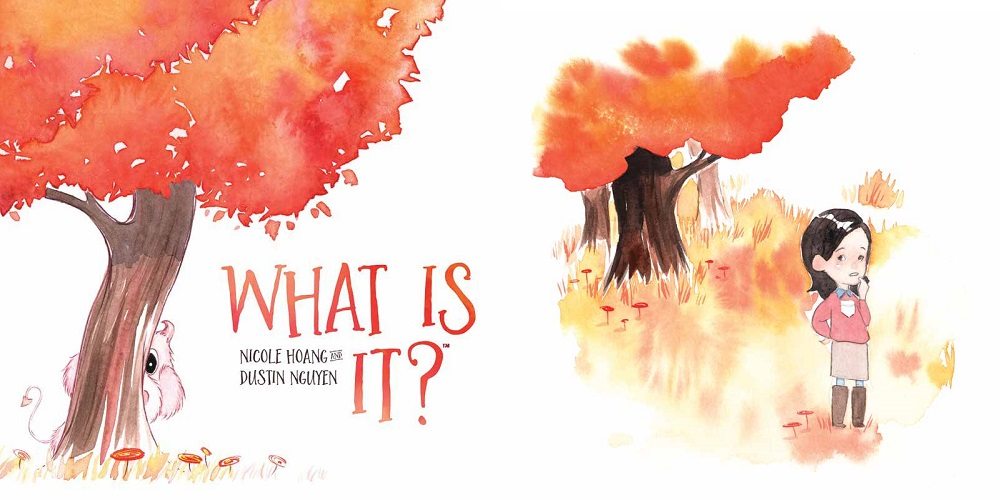Create your own green space by collecting plants and arranging them in rooms to get just the right amount of light.
What Is Verdant?
Verdant is a tableau-building game for 1 to 4 players, ages 10 and up, and takes about 30–45 minutes to play. It’s currently seeking funding on Kickstarter, with a pledge level of $29 for a copy of the game. The rules are fairly easy to learn, though some of the scoring can be a little tricky; players younger than 10 will be able to enjoy putting together the rooms and plants and items, but may not be able to figure out the best tactics.
Verdant was designed by Molly Johnson, Robert Melvin, Aaron Mesburne, Kevin Russ, and Shawn Stankewich. It is published by Flatout Games, with illustrations by Beth Sobel.
New to Kickstarter? Check out our crowdfunding primer.
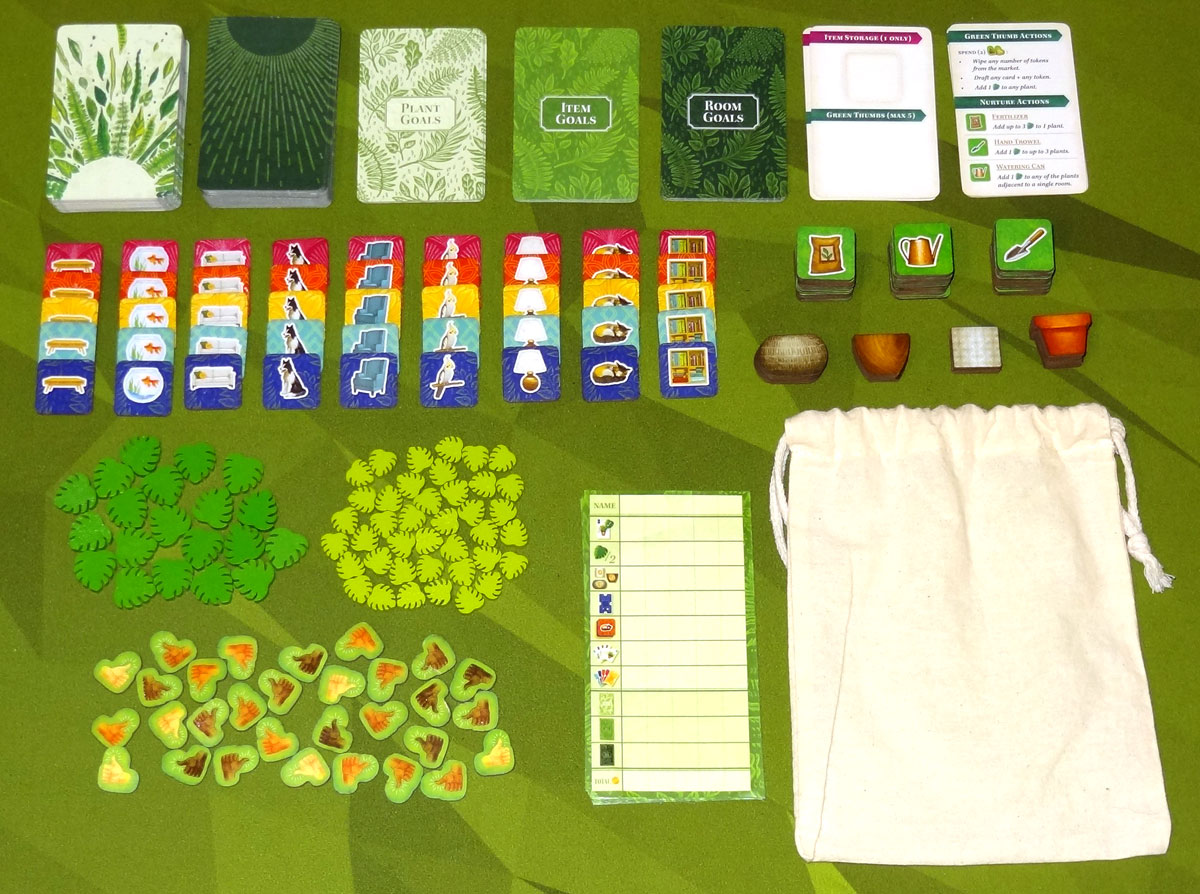
Verdant Components
Note: My review is based on a prototype copy, so it is subject to change and may not reflect final component quality. The prototype was pretty polished, though, with most of the artwork completed, so the finished product will probably look fairly similar aside from upgrades due to stretch goals.
Here’s what will come in the box:
- 50 Plant cards
- 50 Room cards
- 8 Plant Goals cards
- 8 Item Goals cards
- 8 Room Goals cards
- 4 Item Storage cards
- 4 Player Aid cards
- 45 Item tokens (9 item types in 5 colors each)
- 45 Nurture tokens (15 each of 3 types)
- 36 Pot tokens (6 each concrete, wood, ceramic; 18 terra cotta)
- 20 Large Verdancy tokens
- 40 Small Verdancy tokens
- 36 Green Thumb tokens
- Scorepad
- Cloth bag
Kickstarter backers will also receive a free mini-expansion of 10 potless plants, and 6 additional goal card. (These were not included in the prototype.)

The cards are vibrant and colorful—room cards are colored with wallpaper patterns to help differentiate them further and the plant cards, illustrated by Beth Sobel, are realistic looking, with a fact about each plant at the bottom of the card (in fairly small text). The plants have colored ribbons marking their type (like succulents or cactus), and these icons are also on the room cards so you can tell which ones match even without relying on the colors. One fun touch: the pot tokens are the same height as the illustrated pots on the cards, so when you place the token on the card, it looks like the plant is in the pot (though without any leaves hanging over the side, of course).

The items include five types of furniture and four types of pets. The colors and backgrounds match the wallpaper patterns of the room cards.
The verdancy tokens are wooden tokens shaped like slotted leaves, in two sizes and shades of green, and the green thumbs are cardboard tokens showing a hand with a thumbs-up sign. I like the fact that there’s a mix of skin tones on the thumb tokens, too.
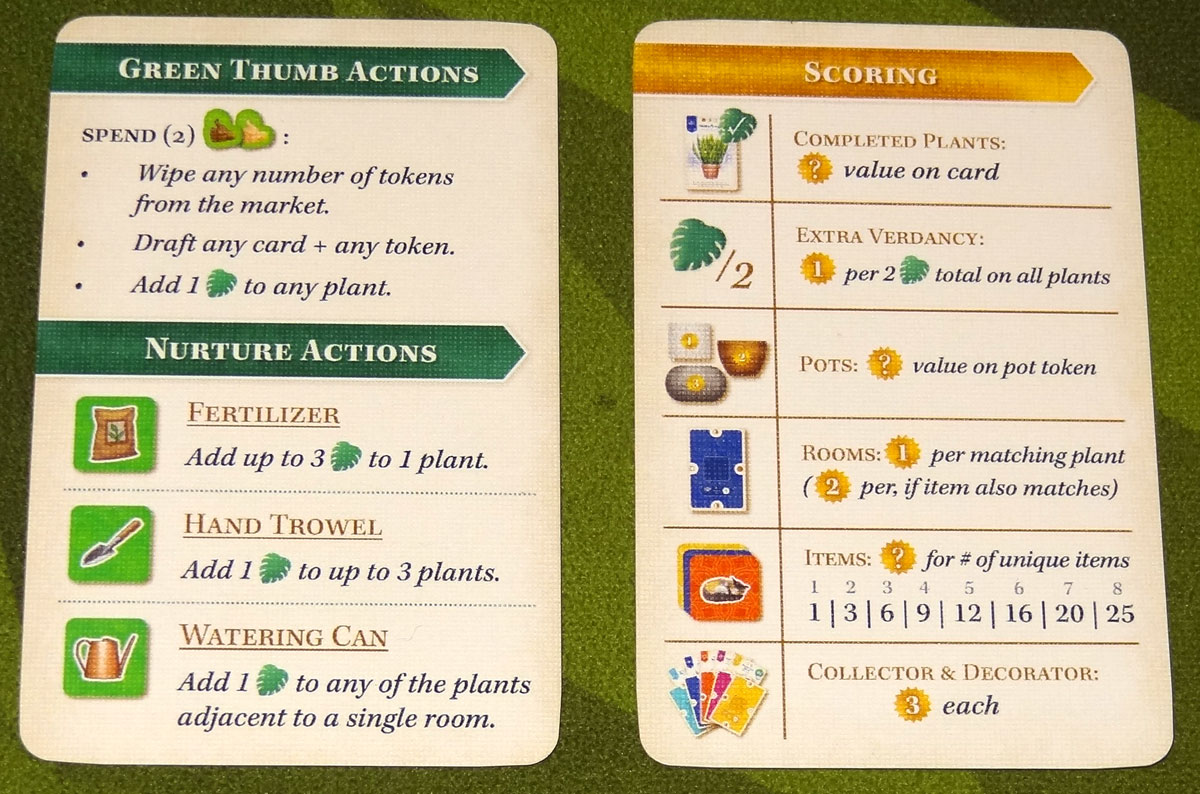
How to Play Verdant
You can download a draft of the rulebook here, and it’s also available to play for free on Tabletopia.
The Goal
The goal of the game is to score the most points by arranging your plants and pots, and completing the goals.
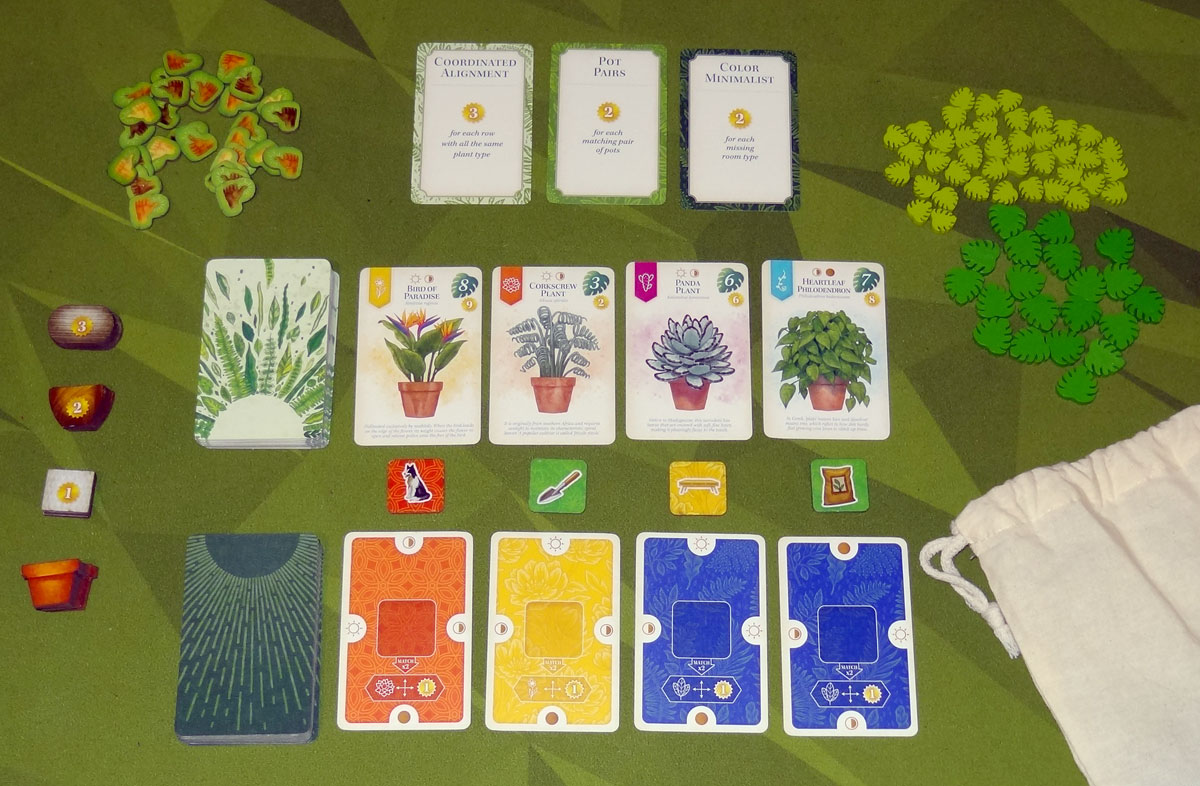
Setup
Shuffle the plant cards and the room cards separately and deal one of each to each player. Create a market with 4 plants and 4 rooms, with the decks nearby. Put all of the item and nurture tokens in the bag and mix them up, and then draw four tokens and place them between the plants and rooms in the market.
Shuffle each of the goal types and draw one of each, placing them near the market. (For a simpler game, you can omit the goals.) Place the rest of the components—pots, thumbs, and verdancy tokens—nearby.

Each player starts with 1 room and 1 plant, which they need to place adjacent to each other (vertically or horizontally). If the lighting icon on the side of the room card matches one of the lighting requirements of the plant card, then put a verdancy token on the plant. The player with the highest verdancy requirement (the number in the green leaf at the top right of the plant card) is starting player.
Each player should also receive an item storage card. The starting player gets no green thumbs, the last player gets 2 green thumbs, and everyone else gets 1 green thumb. You may have up to 5 green thumbs, stored on your card.
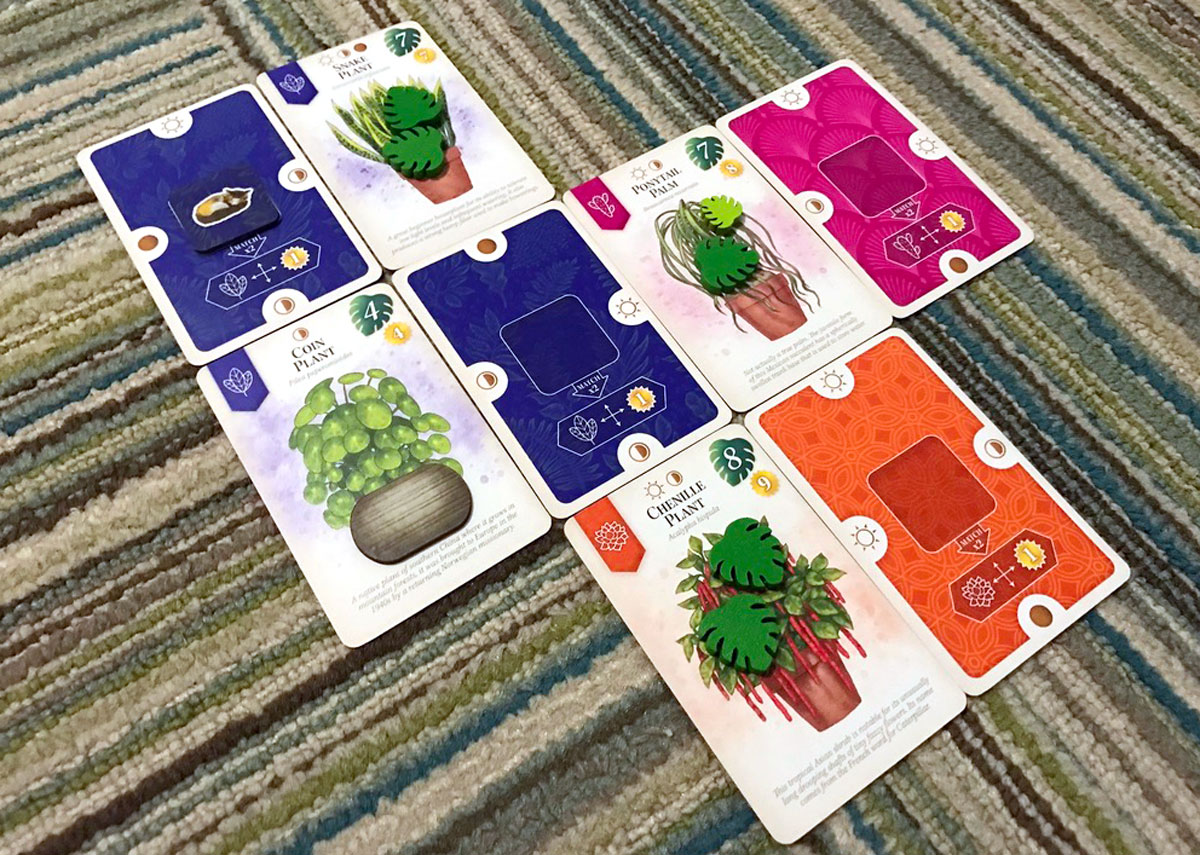
Gameplay
On your turn, you must choose a card and a token from the same column; if there are any green thumbs on the card, you take those as well. Add a green thumb token to the card remaining in the column.
Then, add that card to your grid, adjacent to an existing card. Your grid will be 3 cards high and 5 cards across when the game ends, and you must stay within those bounds as you add cards. The grid must be a checkerboard pattern of rooms and plants—rooms are adjacent to plants, and plants are adjacent to rooms.

Each time you add a card, if it creates a new match between lighting requirements on a plant and the lighting conditions on that side of a room, then you add a verdancy token to the plant. If you accumulate enough tokens to meet the verdancy requirement for that plant, then remove all the tokens and take the highest-valued pot and place it on that card. That plant is now complete, and you will not add any more verdancy tokens to it.

The nurture tokens have green backgrounds, and may be discarded for their effects:
- Fertilizer: Add 3 verdancy to a single plant.
- Watering Can: Choose a room, and add 1 verdancy to each plant adjacent to that room.
- Trowel: Add 1 verdancy each to 3 different plants.
(Any verdancy over a plant’s limit is lost, and you may also choose to forfeit placing all of the verdancy.)
Items (furniture and pets) may be placed into an empty room—once placed, they may not be moved.
The green thumbs can be spent for different effects; each effect requires you to spend 2 thumbs:
- Wipe any number of tokens from the market, draw from the bag to replace them, and then put the wiped tokens back in the bag.
- Take any card and any token on your turn (rather than from the same column).
- Add 1 verdancy token to any of your plants.
At the end of your turn, you must discard down to 5 green thumbs and 1 item or nurture token. Refill the market with a card and a token.
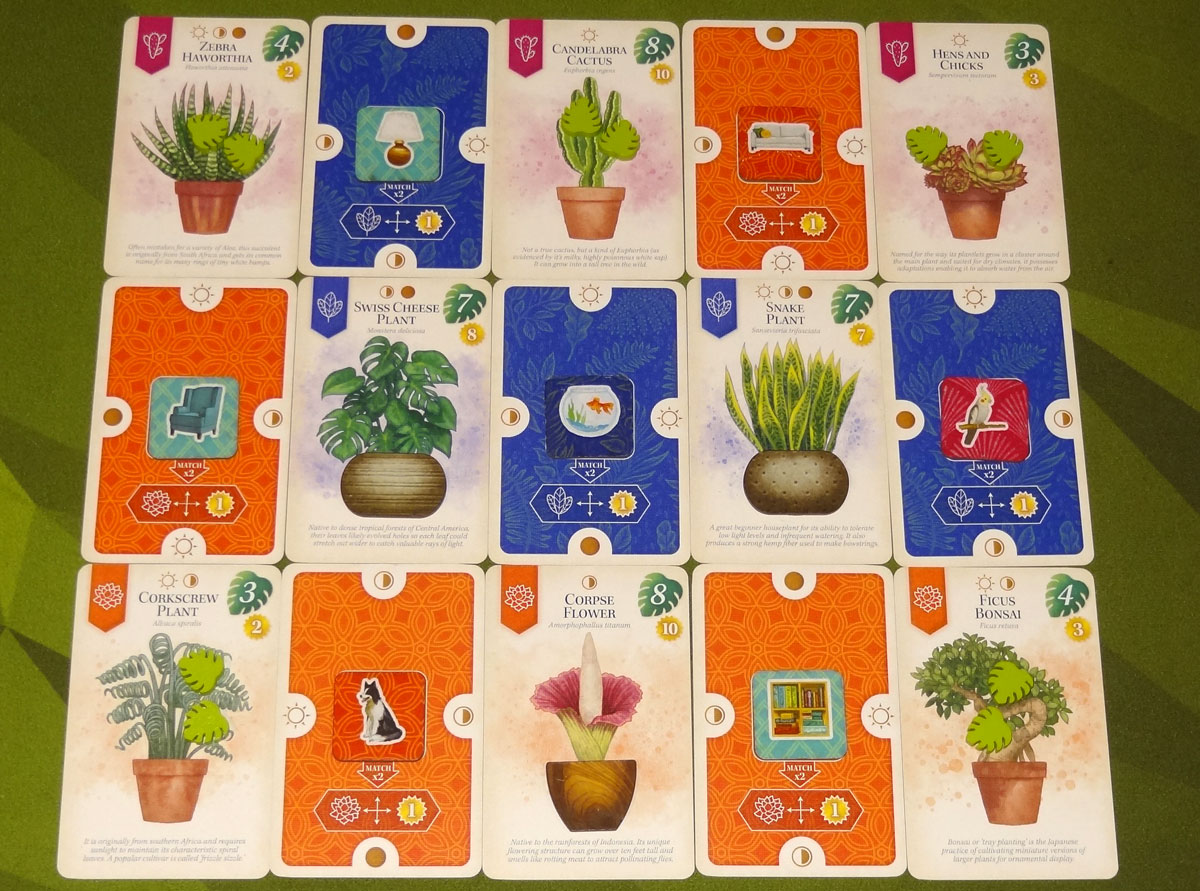
Game End
The game ends after everyone has filled their grids, which takes 13 rounds.
Scoring is as follows:
- Completed plants are worth the number shown on the card in the yellow sunburst.
- You score half (rounded down) of your total verdancy on your incomplete plants.
- Pots are worth the points printed on them.
- Each room is worth 1 point for each adjacent plant that matches it. If the room has a matching colored item in it, then it’s worth 2 points per plant instead.
- You score points based on how many unique items you have.
- You get 3 points if you have at least one of each plant type.
- You get 3 points if you have at least one of each room type.
- You score points for goal cards that you’ve achieved.

There are always three goals: one has to do with plants, one has to do with items, and one has to do with rooms. Some score based on who has the most of something, and some give you points per times you achieve it.
The highest score wins, with ties going to the player with more green thumbs.
Why You Should Play Verdant
Flatout Games has a growing reputation for thinky drafting games, and I’m into it. Their first title was Point Salad in 2019 (which was one of our Game of the Year finalists), and since then I’ve reviewed a few more titles from this design team like Calico (another finalist), Cascadia (Kickstarted last year and delivered to backers this year), and Dollars to Donuts (Kickstarted last year, in production now). Now, these games aren’t the same—they have different mechanics and different themes—but you can tell they share some gaming DNA. In all of the games, you’re collecting things from a common market and trying to squeeze as many points as you can get from them. Aside from Point Salad, all of the games also involve a bit of tile-laying (or card-laying) where the physical placement matters, creating a sort of puzzle for each player to solve.
Verdant is lovely to look at: the colorful wallpaper and the wonderfully illustrated plants make for a really pleasing tableau. As somebody who struggles to keep plants alive, I found it satisfying to be able to match up plants with their favorite lighting conditions and help them “grow”; they’re certainly easier to take care of than real plants. What makes the game tricky, of course, is trying to chase all of the different things that are worth points. You’ll get a few bonus points if you have all five plant colors and all five room colors, but each room gets more points if it’s surrounded by plants that match it. So there’s a bit of a tug-of-war between wanting all of your plants and rooms to be the same color (thus maximizing room points) and diversifying for that bonus. Add in the goal cards, and you might have even more incentive to focus on fewer colors.
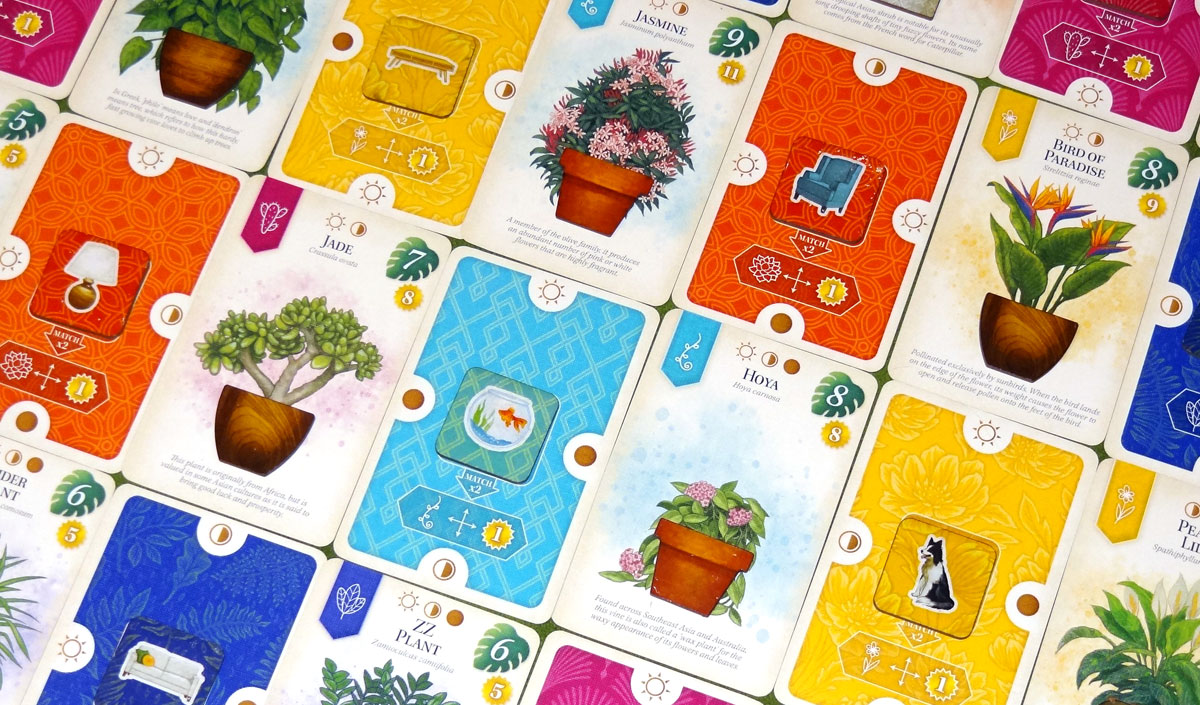
Of course, things don’t always match up the way you want them to. You might have to choose between a plant that matches the room color and a plant that matches the lighting condition. Sometimes there’s a room that you want and a plant that you want, but you only get to take one of them, and chances are somebody else will take the other before your next turn. Sometimes the plant is just perfect for an opening in your house, but the item it comes with is something you already have, and the wrong color to boot. If you get frustrated when things don’t line up perfectly, then Verdant is guaranteed to cause frustration. Admittedly, that’s the sort of tension that I really enjoy in games, being forced to choose between two imperfect options and trying to make the best of it.
The green thumbs can toss some items you don’t want and refill them—that’s great when you’re fishing for a couch or you really hope you get a bag of fertilizer. But there’s no way to cycle the cards on your turn—what you see is what you get. I know that has also been frustrating for some players when I’ve played it, because sometimes you’re at the point where you just have to take a room card, and none of the four are what you want. Again, that’s part of the game: if everyone were always able to draw whatever room or plant they wanted, it wouldn’t be much of a challenge. The only way to get more green thumbs (beyond your starting supply) is to take a card that has thumbs on it—so essentially you have to take something that somebody else passed up. Sometimes there are cards that nobody wants, and the thumbs will just pile up until eventually somebody thinks it’s worth it. Other times, a card that doesn’t work for you might be excellent for the next player, so you’ll need to be aware if you’re just adding thumbs to something they were planning to take anyway.
The 3×5 grid gives you a little bit of flexibility, because you don’t have to start at a particular point in that grid: you can build in any direction from your starting pair of cards. But once you’ve hit 3 cards high or 5 cards wide, you’ve defined the limits of your house and then you have to stick inside those. Also, because the house has to be a checkerboard pattern, that can dictate which card type you’re able to take on your turn. If you keep collecting rooms, at some point you’ll have no more open spaces for rooms and have to take a plant.
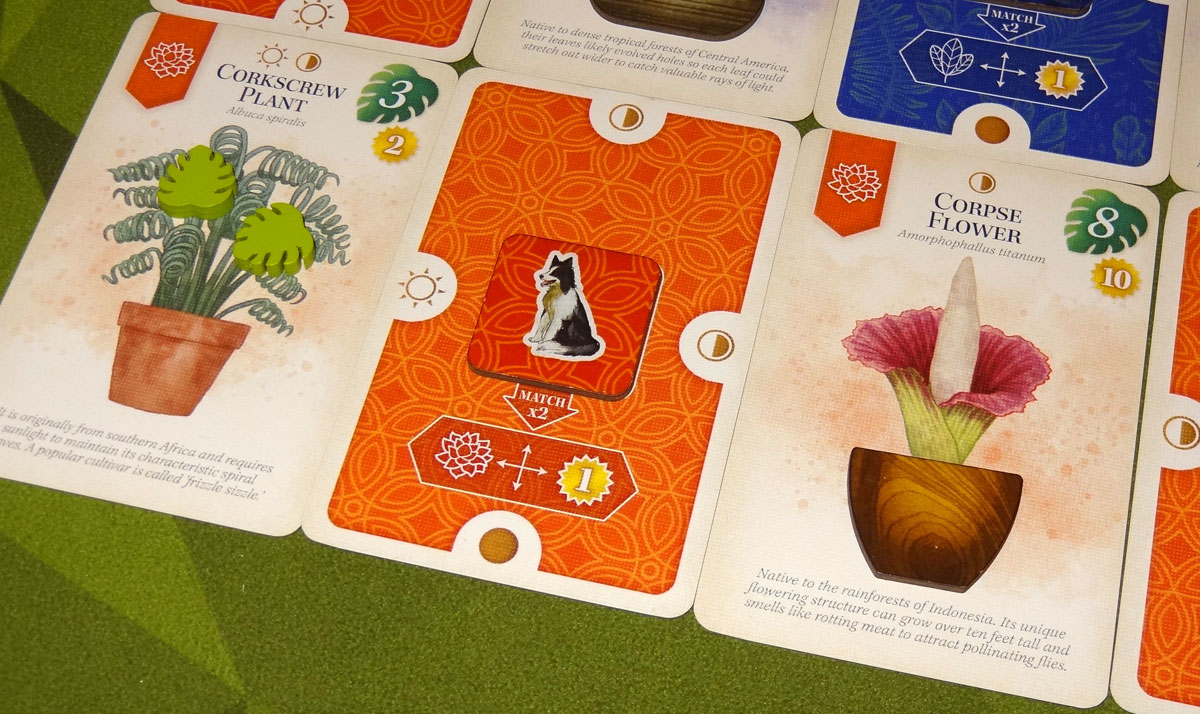
I did feel like the scoring is a bit more complicated than some of the other Flatout Games, just in terms of the number of different categories of things that you score: plants, rooms, pots, items, goals. And in particular, the one that trips people up is the rooms and matching color items. A matching item doubles the value of the room itself—but the room’s score is based on how many adjacent plants match its color. In the photo above, the orange room has two orange plants adjacent to it, so that would be a base score of 2 points; the matching dog in the room doubles it to 4 points. Many times, I had players trying very hard to get a matching colored item for a room that had no matching plants next to it, thinking that the match itself was worth points—but double nothing is still nothing. In that case, you’re usually better off trying to get the collection of different items, because those are worth points even if the colors don’t match.
Often in the game you’ll have to to decide between items and nurture tokens, too. Items make rooms worth more and have a set-collection score; nurture tokens help you get your plants growing so you can score points. Since you score half of your total verdancy at the end of the game for incomplete plants, finishing a plant is roughly double the value—not to mention the bonus for the pot if you get it done early enough. It can be hard (though not impossible!) to fill all your rooms with items and get all your plants watered in time.
While it’s certainly easier to leave out the goal cards the first time you play, I highly recommend using them once you’re familiar with the rules. Without the goal cards, everyone is trying to complete plants quickly (to get the most valuable pots) and usually trying to collect all five colors of rooms and plants. The goal cards can really change things up. For instance, one pot goal awarded points for each set of all four different pots. That makes it more important to time the completion of your plants more carefully, so that you don’t end up missing out on one of the pot types. The Color Minimalist goal gives you 2 points for each room color you don’t have—if you started with a yellow room, maybe you’ll have very little competition for other yellow rooms in the market.

I got to play Verdant several times with a few different groups while I had the prototype, and I really enjoyed it. My youngest daughter (age 8) was able to learn the rules pretty easily, though we usually played without the goal cards so there wasn’t quite so much to keep track of. Playing with adult friends made for some pretty competitive games, too. Although each player is working independently on their own house, it’s quite possible to take a card or token that somebody else wants, whether inadvertently or intentionally. You can try to plan out your strategy in advance, but a lot of the time you can’t be sure what your options will be until it’s actually your turn.
Verdant is another lovely game in the Flatout Games lineup. If you enjoy drafting games and puzzles, it’s worth taking a look to see how green your thumb is. For more information or to make a pledge, visit the Verdant Kickstarter page!
Click here to see all our tabletop game reviews.
![]() To subscribe to GeekDad’s tabletop gaming coverage, please copy this link and add it to your RSS reader.
To subscribe to GeekDad’s tabletop gaming coverage, please copy this link and add it to your RSS reader.
Disclosure: GeekDad was loaned a prototype of this game for review purposes.





